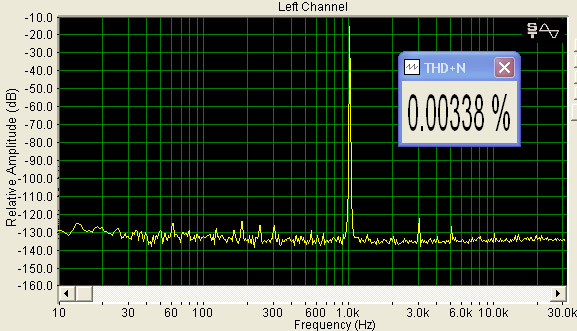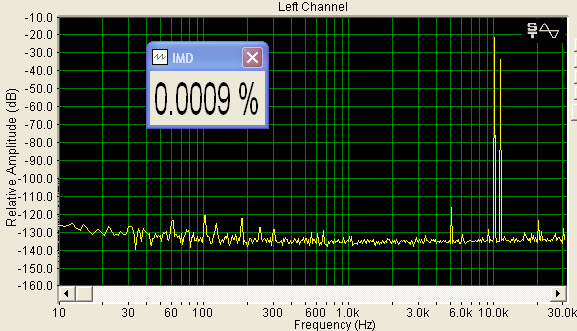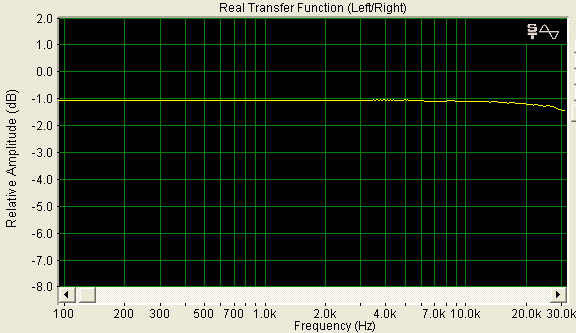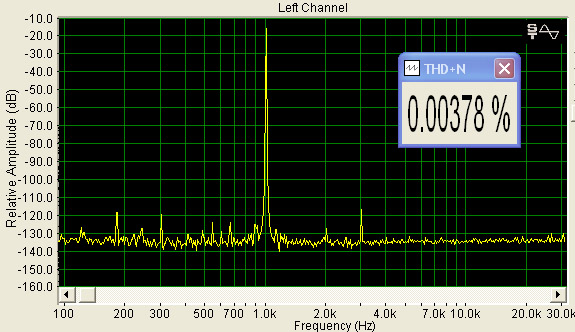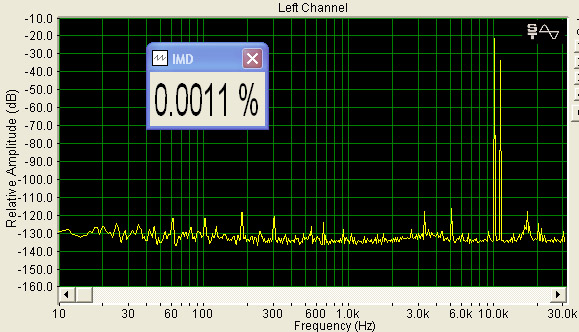|
||||||
|
On the Bench (Sandy Bird)
Our result for THD+N in Analogue-Direct came in well within spec of 0.006%.
For IMD, our results were also within the published spec of 0.001%.
Frequency response through Analogue-DSP is exactly what we expect: Ruler flat through the audible band (down by only 0.2 dB at 20 kHz).
Switching to Analogue-DSP, we again see THD+N measuring within spec.
IMD in Analogue-DSP mode is the same as the published spec of 0.001%. So, Let's Have a Listen - The Sound Anthem sent, with the D1, their massive Statement P5 amplifier. No, the D1 does not need a P5 to work right. However, to fully appreciate the efforts of their engineers, the upsampling, the Bessel Filter, and all that that implies, you want a really silent amplifier. With that in mind, Anthem one upped the already incredible MCA and PVA amps with the Statement models (which we will review separately). Let's cut to the chase: the answer to the question you've all been waiting for, "Does it sound better than then AVM-20", is a "yes". But how? The AVM-20 is already remarkably transparent and looking back, I see that I described its sound as "real", "believable", and so on. The D1 usurps it by taking away any notion, hint, or perception that you are listening to digital audio. This is somewhat ironic: While the analog pass-through is as good as anything I have ever heard, there is in the opinion of this writer, no use for it. The D1's digital section is such that you can mothball that DAC you bought and just feed the D1 whatever digital stream you've got. As for true analogue sources, including Vinyl, or maybe open reel, hard pressed will you be to realize any benefit of keeping it analog when you can let the D1 digitize it, bass manage it, and all that jazz. DVD-A? I defy you to tell the difference between Analog-Direct and Analog-DSP (all else being equal). Besides, very soon now the IEEE-1394 (Firewire) jack will be in place at which point there will be no question on how to set up DVD-A. Yes, it's that good. Your CD collection never sounded this good. Or maybe I should say, never sounded this exposed. "Exposed"?!? Yes, exposed. All we can ask a product to do is play what has been captured. Sadly, there are more examples of subjectively "poor" recordings than "good" ones, especially in the realm of pop music where dynamic range compression and spiced up treble are the norm. Do not expect with a D1 to never again hear sibilance. However, you can rest at night, confident that when you do hear it, it's not the fault of your processor. We spun my usual suspects, what I consider tenets of good audio engineering. Mark Knopfler's gang knows what they are doing, and here at last we can explore all the fruits thereof: Insane exploitation of the CD's dynamic range and unusual clarity in the voice, the guitars, the percussion. I almost get more enjoyment out of Rusel Malone's guitar on Diana Krall's Love Scenes than Diana herself. The warmth and slight distortion of the electric guitar is intoxicating. "Is this really digital audio?" I kept asking no one in particular. Supertramp's Crime of the Century, Paul Simon's landmark Graceland, Sting's Dream of the Blue Turtles. CDs began to be scattered all over the 007 Theater in a frenetic musical journey (which later prompted me to put them all into Windows Media 9 Lossless, but that's a tale for another day). It sounds so darn analog through the D1! And I told myself I was not going to wax poetic. Naturally, the D1 could do nothing for Alanis Morissette's botched Jagged Little Pill, it could not magically restore dynamics to Kate Bush's Hounds of Love (which sadly has almost none at all), nor could it correct the irritating and pervasive "ssshh" in Amanda Marshall's self titled album. Neither can anything, which is why I'll just make one quick appeal here to audiophiles to spend a little more time voicing concerns over media quality and a little less obsessing on equipment. The order of the day here is absolute neutrality. Bright/Dark, Fat/Lean, Warm/Harsh. I just can't take any portion of the spectrum and pigeon-hole it for you. Sorry. Everything is just "right". With Dolby Digital and DTS soundtracks, you will believe you are hearing analog master tracks, not compressed bitstreams. While there are always bad examples in movies, more often than not the audio engineering is excellent because unlike the music industry, the movie business governs itself with standards and rules. Here, the D1 just floored us with its ability to recreate the incredible effort that goes into most modern motion picture soundtracks. Das Boot was meticulously remixed for theatrical re-release in 1997, and the resultant DVD holds up with the best. The D1 articulates all the texture of the original German, which of course you are playing if you are a true movie connoisseur (with subtitles if need be). Yo yo Ma's contribution to Crouching Tiger Hidden Dragon nearly moved me to tears. As for anything from the gang at LucasFilm, Episodes One and Two, the reissue of the Indiana Jones films, etc, here's a prediction: I wager that a few D1s will find a place in some of the Home Theater rooms at Skywalker. It just so happens the D1 was in place in time to catch me screening the re-release of Saving Private Ryan, a movie not to be taken lightly or spun carelessly as demo material. How did this best of the best soundtracks sound? It was so transparent I ceased to "notice" it and just absorbed the movie as a whole. And isn't that the whole point? If it is so, then the D1 is, by any stretch of the definition, a huge winner. Conclusions The one point vital to understand my conclusion has yet to be covered: The D1 is only $5,000. This is an appreciable sum to be sure, but when we consider it is not "twice" the price of the AVM-20 as originally rumored, the improvements not only seem desirable, but reasonably priced. Also, don't forget that some of the mass market components are in this price range now. The D1 is half the price of anything out there which I could considered for comparison against it. This concerns me because Anthem (and indeed Paradigm) price their products so fairly below where the rest of the industry names want things to be, that you might not take them, or my comments about them, as seriously as you ought. If you like bragging to friends about how much your house, car, jewelry, golf clubs, or indeed A/V equipment costs, be my guest at spending more than you have to. For those who work hard for their honest buck, who seek and appreciate value above all, get away from the computer, find a dealer, and see (hear) for yourself why in the opinion of this writer, the D1, for the time being, is the final word in Surround Sound Processors.
Go to Part I - Introduction, The Design, and Functionality Go to Part II - Speaker Setup, Bass Management, and Upsampling Go to Part III - On the Bench, The Sound, and Conclusions * At the time of this writing, the Motorola code for Pro Logic IIx still was not complete, though the fact that the logo is on the front of the D1 is your guarantee that it will be provided for free through an imminent software revision.
|
||||||
| u | ||||||

